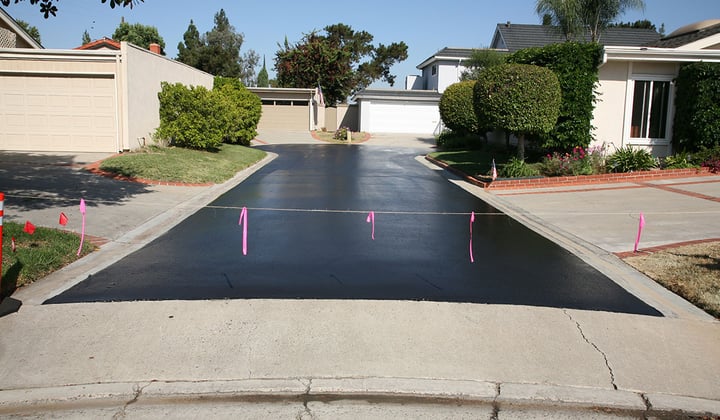Warm Mix Asphalt: A Lasting Solution for Pavement
Hot Mix Asphalt (HMA) has become a leading sustainable option for pavement services, offering a myriad of ecological benefits and innovative innovations. Its capacity to reuse products and minimize energy consumption presents an engaging instance for its adoption in road building and construction tasks. The lasting performance and sturdiness of HMA make it a favored alternative for infrastructure development. As the need for green construction techniques expands, discovering the subtleties of HMA's sustainability can provide important understandings into the future of sidewalk services.
Ecological Benefits of Hot Mix Asphalt

Furthermore, Warm Mix Asphalt aids to alleviate urban warmth island impacts. Its dark color soaks up sunlight, minimizing the amount of warmth reflected back into the ambience contrasted to lighter-colored sidewalks. This can lower ambient temperatures in urban areas, reducing the demand for a/c and ultimately reducing energy usage.
Additionally, Warm Mix Asphalt adds to improved stormwater administration. Its permeable nature permits water to recharge and infiltrate the pavement groundwater supplies, lowering drainage and the danger of flooding. These ecological advantages make Hot Mix Asphalt a sustainable selection for paving freeways and roads.
Energy Efficiency in HMA Manufacturing
Is power efficiency a crucial consider the manufacturing of Warm Mix Asphalt (HMA)? Absolutely. Power plays a significant role in the production of HMA, impacting both cost and ecological sustainability. One crucial facet of power performance in HMA production is making use of cozy mix asphalt (WMA) modern technologies (regrading). WMA permits the mixing and placement of asphalt at reduced temperature levels compared to standard hot mix asphalt, leading to decreased energy intake during manufacturing. This process not just lowers fuel use but likewise lowers greenhouse gas emissions, making it an extra environmentally pleasant option.
Additionally, innovations in plant innovations have actually led to even more energy-efficient HMA manufacturing procedures. By maximizing power usage in HMA production, the market can minimize its carbon impact while maintaining top notch sidewalk products.
Recyclability of Hot Mix Asphalt
The recyclability of Warm Mix Asphalt (HMA) is an essential element of its sustainability and lasting environmental effect. HMA is just one of one of the most recycled products in the USA, with over 100 million heaps of reclaimed asphalt sidewalk (RAP) being reused yearly in new sidewalk building. Reusing HMA offers several environmental benefits, such as decreasing the requirement for virgin products, decreasing power usage throughout manufacturing, and lowering the amount of waste sent out to land fills.
The process of reusing HMA entails milling the existing pavement, squashing it right into smaller items, and blending it with brand-new accumulation and asphalt binder to produce a recycled mix. This recycled mix can typically carry out along with and even much better than traditional HMA, while needing less raw products and generating reduced greenhouse gas discharges. By including RAP right into brand-new pavement projects, road agencies can save natural resources, lower costs, and reduce the environmental footprint of roadway Check Out Your URL building and construction and maintenance tasks. On the whole, the recyclability of HMA plays a significant function in promoting lasting practices within the sidewalk industry.

Long-Term Performance of HMA
Asphalt pavements demonstrate longevity and resilience over a prolonged period, mirroring the lasting efficiency of Hot Mix Asphalt (HMA) Additionally, improvements in HMA modern technology, such as the use of polymer-modified binders and cozy mix asphalt, have actually additionally enhanced the sturdiness and longevity of HMA sidewalks. By focusing on top quality construction and maintenance practices, HMA proceeds to verify itself as a sustainable and affordable option for durable pavement facilities.

HMA: Durability and Sustainability
Showing both sturdiness and sustainability, Hot Mix Asphalt (HMA) has actually come to be a foundation in the building of durable sidewalk infrastructures - regrading. HMA's longevity comes from its capability to endure hefty loads, severe weather, and high website traffic volumes, making it a trustworthy option for roadways, freeways, and airport runways. The composition of HMA, which usually consists of accumulations, binder, and filler, plays an important function in improving its long life and resistance to wear and tear
Additionally, HMA's sustainability lies in its recyclability and energy-efficient production process. The ability to recycle recovered asphalt sidewalk (RAP) in new HMA mixes lowers the need for virgin materials and lessens the ecological effect of sidewalk construction and upkeep. Furthermore, the power effectiveness of generating HMA hinges on its reduced blending temperatures contrasted to various other sidewalk products, leading to minimized power consumption and greenhouse gas emissions.
Final Thought
In conclusion, warm my sources mix asphalt (HMA) uses a sustainable remedy for pavement with its environmentally pleasant features. HMA's recyclability, power performance in manufacturing, and lasting resilience make it an environment-friendly choice for road construction.
HMA is one of the most recycled products in the United States, with over 100 million tons of recovered asphalt pavement (RAP) being recycled yearly in brand-new sidewalk construction.The procedure of reusing HMA involves crushing the existing pavement, squashing it right into smaller sized items, and blending it with new aggregate and asphalt binder to create a recycled mix.Asphalt pavements show helpful site longevity and resilience over an extended duration, showing the lasting performance of Warm Mix Asphalt (HMA) In addition, advancements in HMA innovation, such as the usage of polymer-modified binders and warm mix asphalt, have even more improved the sturdiness and long life of HMA sidewalks. The ability to reuse redeemed asphalt pavement (RAP) in brand-new HMA combinations decreases the need for virgin materials and lessens the ecological impact of sidewalk construction and maintenance.